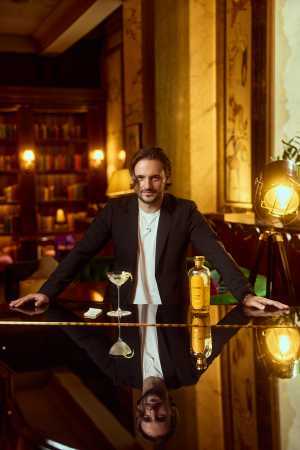Whenever you taste a neat spirit, the first sip will always be quite hot,” says Alex Watson. “So you should let it coat your tongue and your mouth, then come back and do a second circuit. You’ll get a lot more out of it a second time.”
Watson knows his booze; the man basically grew up in a glass. Teenage summers were spent picking grapes on his father’s Chablis vineyard; during term-time he worked weekends at Covent Garden tequila bar Café Pacifico. After a brief foray into the world of modelling, he landed a dream job at global drinks company Diageo and spent his twenties working with premium spirit brands. Now he’s launched a gin brand of his own, alongside his older sister Emma – you might also know her as an actor.
Over cocktails in Scarfes Bar – gin based, naturally – Alex tells me the story of Renais from conception to creation. He makes a fine drinking buddy: erudite, convivial, and palpably proud of the beautiful spirit bottle that sits on the table between us.
Renais is not only a labour of love but a statement of identity. Used grape skins from the Watson family vineyards are recycled to create the gin itself. Chablis is embedded into its taste. “We use limestone and rock salt to try and reach some of the minerality that Chablis has,” explains Alex. “When you chill it down with the ice cube and it dilutes it ever so slightly, you pick up some of that structure that sits underneath the floral and citrusy notes. So it keeps developing as you drink it.”
Glasses are poured. We take it neat, a rarity for gin but it goes down delightfully – and I’m not much of a gin drinker. “You’re who we want to convert,” smiles Alex. He notes the absence in the market of a sipping gin, something you enjoy on the rocks after dinner. “Maybe in place of a brandy. You have a beautiful dinner, have it as a cocktail before. But then you get it on ice, you can put a little twist of lemon peel in there and you have it neat. Nothing would make me happier.”
Consider me converted – and I’m far from alone. In barely a year, Renais has established itself as an exciting addition to the world of spirits. For Alex Watson, the journey has been one of immense personal fulfilment – and it’s only just beginning…
Square Mile: Renais Gin is in approximately 120 bars in the UK. Do you have a target number in mind?
Alex Watson: It’s tricky. I would so much rather have it in the right bars with the right bartenders rather than be spread more widely in places that aren’t quite right for us. It can be a bit of a vanity metric to be like, ‘We’re in a thousand bars’ or whatever. I’d rather be in fewer bars but be well received and do well there.
SM: Tell us about the grapes…
AW: There are three different sets of grapes that go into Renais – so I hope you’re comfortable. So, the alcohol for the gin comes from the recycled grape skins and also something called the lees, which is a sort of yeast byproduct that comes from the wine-making process. You can take both of those things and ferment them and distil them because there’s enough residual sugar left over in them. That’s where the alcohol comes from.
The provenance of the grapes that go into making it includes my family’s vineyards in Chablis, which is super important for me. It’s pretty small and all of the grapes get mixed together from the neighbouring region so we can’t really point to one as the sole supplier.
We use grape skins as a botanical, which we blend and macerate into the gin afterwards. They also come from Chablis. We blend a little bit of chardonnay grape juice, which is where you get that little hint of sweetness and a little hint of colour in Renais, chardonnay being the grape variety for Burgundy, where my family makes wine. So you’ve got grapes three ways.

SM: How many grapes go into a bottle?
AW: At the point the grapes have been pressed to extract all of the juice, there’s not a huge amount of sugar left in them. So the volume of grape skins that you have to ferment in order to create the alcohol is enormous. Which is why it’s only done in a handful of places – and what we do with it is quite unusual.
A lot of wine-producing regions have very rich traditions of recycling the grapes skins and making local products with them. Eaux-de-vie is one example. But I didn’t really want to touch any of that and there’s not much I have to contribute to those traditions. Gin making is something that the UK can throw its hat in the ring for.
We found a second facility that would continue to distil or rectify our spirit into a vodka, which is quite unusual. They mostly leave it at about 80% to make those other local products. So we take it to a second distillery to make vodka, import the vodka back to the UK and then we make a gin. All gin has to start from vodka; technically, all gin really is juniper-flavoured vodka.
SM: How do you know when the gin is ready to drink?
AW: You can keep going forever if you want. I work with people who are much smarter than me. It is a good secret. People who tell you when to stop and tell you what’s feasible and what’s not.
The way that we do it isn’t a straightforward way of making gin. If you keep fiddling with it, you can make something that’s impossible to produce properly. We had to stop at a certain point.
SM: And you only have two weeks to pick the grapes…
AW: That’s when the harvest happens, yeah. With regards to the ones that we use as a botanical, you can only collect them for two weeks of the year. In practice, we collect and store some, so it’s not quite as dramatic as that. But I’ll be back this October during the harvest season.
It’s the beautiful thing about winemaking in France – there are all these seasonal calendar moments that you can be a part of. So in February they have a festival called the Saint-Vincent: he’s the French patron saint of wine. It’s a really beautiful local tradition. And then you have the harvest festival in October where all the wine makers come and exhibit their wines.
Because my dad’s been winemaking for 30-odd years, he is part of those ceremonies and stuff. He’s something called a pilier, which is sort of the highest rank in the winemaking community. He’s involved in determining when the harvest starts and finishes, and he parades around when they do the festivals and stuff.
SM: How did you come up with the idea for Renais?
AW: My entry into the world of drinks was French winemaking because of the vineyards – as I mentioned, Dad had been doing it for 30 years. But I went into the spirits industry, I’ve been working in spirits and hospitality for the last ten years.
When I realised that you could use that leftover grape skin to distil and make a spirit, I thought that’s too cool an idea not to try and do. I loved my job at Diageo. But maybe I missed the reason I got into the industry in the first place, which was that sense of community and connection and this rich cultural heritage.

SM: Was it a eureka moment? Or more of a gradual dawning?
AW: It was gradual because I had the idea and then we had to figure out if it was possible. And we only figured out it was possible as we went along. We drove to the distillery in Beaujolais and asked, ‘Can you get us this proof of grape spirit? We want to use it to do this.’ And they’re like, ‘Eh?’
We tasted it and it was awesome. But in the UK, there’s been so much innovation within gin, so I wanted to make sure that we were doing something that was making a genuine contribution to the category, something different. So the idea for the flavour profile was very specific and it took a long while, three or four different makers and distilleries to get the recipe right. It was a long old process.
SM: How long between the idea’s conception and launching the gin?
AW: I’d been thinking about it for years. Years and years. In terms of how long it took to develop the recipe, probably 18 months. Then the design for the bottle and the brand took a long while.
SM: Did Emma design the bottle?
AW: No, Emma did the creative that you see on the website. All of the photography, the videos, even down to the styling that everyone wore on the day. Emma led all of that creative. She’d recently directed a commercial for Prada, working with this amazing team, and off the back of that project she was like, ‘Right, I know how to do this and put it all together.’
I have very little experience with any of that; Emma did an amazing job. She’s the more creative side, I’m more the industry and spirit side.
SM: Was there a particular catalyst that made you take the plunge?
AW: Maybe lockdown. I was living in London and went back to Oxfordshire with my dad. I was working at Diageo at the time. Lockdown happened – all of the bars shut. Brexit happened – swathes of talent from the industry left. Everything was a bit rubbish to be honest. During that period I had a lot of time to think and realised you’ll always regret it if you don’t give it a go.
SM: What were you doing with Diageo?
AW: I did quite a lot of work with the Guinness brand team. I did a lot in Diageo Reserve, which is like the luxury portfolio that Diageo has. I worked a lot on Tanqueray and brands like that. My belief is there’s still some headroom in gin. I don’t think gin has had its moment in luxury in the way that most other spirits have had.
Vodka, whisky, tequila are having great moments. And despite all of the innovation that we’ve seen in gin in the last few years in the UK, none of them have been at that level. Most of that innovation has happened between £25 and £35, I would say. My belief is that there’s still headroom in terms of making a beautiful luxury expression of gin.

SM: Was it always going to be gin?
AW: Yeah, for a few reasons. Personally, I really liked gin. It’s also the backbone of so many classic cocktails. And I wanted to pay tribute to some of the traditions of Burgundy winemaking and French winemaking – so what category is a good vehicle for complex flavours? I think consumers are well adjusted to complex flavours in gin rather than a flavoured vodka or whatever.
I knew I didn’t want to touch traditional French grape spirit products or even brandies and cognac and that kind of stuff. Gin felt like (1) something that personally I really liked but (2) the right vehicle to carry some of the tasting notes and flavours that I wanted to put into the product.
SM: Working on your dad’s vineyard as a teenager sounds idyllic…
AW: Yeah, everyone loves the idea of it! I have a lot of friends who would love to do it. But you gotta wake up at 6am and your day finishes at 2pm because it’s so hot and then you have to sleep. It is stunningly beautiful and it’s amazing. It’s also backbreaking work.
SM: And you went to university?
AW: I studied philosophy, which I haven’t used a great deal. I really enjoyed it at school and at that point there was a bit of a fork in the road. Towards the back end of school, when I was 17, all of a sudden I started getting offered bits of modelling work.
My first photoshoot was with Mario Testino for Burberry – I was on the shopfront in Knightsbridge, there was a 40ft-high Alex! For a period of about 18 months, I had a very brief foray into the world of modelling and quickly found I wasn’t well suited to it.
SM: How come?
AW: A combination of not being particularly good at it and not being very interested in it. So I told my agency I wanted to go to university. I went and did philosophy for a few years and then came out and was like, ‘What am I gonna do?’
All my friends are doing grad schemes in accountancy or consultancy or all of these different things. Even at 21, I’d already worked a lot in hospitality – as a teenager I’d work at a bar called Café Pacifico in Covent Garden. It was London’s first tequila bar. I fell in love with it. Going to school, and then at evenings and weekends, I’m working at this incredible bar.
After uni, I worked on the vineyards in France for a few months. And then I had a moment where I was like, ‘You love hospitality, you love drinks and you could quite happily make that your career.’ So I did a grad scheme in hospitality management, rotated around working in hotels, bars, restaurants, every imaginable thing you can do in hospitality. It took me on a journey that ended up at Diageo.

SM: Did your dad give you any advice?
AW: Initially he was probably a little bit fearful for me because he knew that I’d worked really hard to get that job at Diageo. But the more I spoke to him about the project, the more I was able to win him round. And now he loves it! It’s so sweet because we get to travel around and talk about it. We do tastings where we do the wine and then we do the gin. It’s really cool.
SM: When did Emma get involved?
AW: Like me, she grew up picking grapes and working on the vineyard and is a second generation winemaker. When I explained that I’d been chatting to dad and we were doing the project, I think the sustainability element was super important to her – when I’d explained that what we were doing helped reduce waste and it’s a really forward-thinking, sustainable way of making spirits. She was like, ‘Yeah, absolutely. I’m in!’
She’s really lent her creativity to the project. There are a bunch of things that she’s good at that I’m not particularly good at. It’s very sweet that it’s a whole family project.
SM: Lots of celebrities have launched spirits brands in recent years. But for you guys, it’s not a case of jumping on a trend – it’s something that’s part of your identity…
AW: Exactly. If I could, the message I would try to explain to people is that my family has been in the business since before Emma was born. I’ve been working in the industry for the last decade. Consumers are right to form their own opinions and maybe be sceptical of different situations. That’s fair. In our case, we’ve been doing it for a really long time. It’s very personal and important to us.
SM: How is it working with your sister? Mine would murder me after a week.
AW: It’s great. It has happened at a really nice time for both of us in our careers. We really like getting to work with each other now. It’s a bit of a privilege to be able to work on something like this together.
View on Instagram
See more at renais.co.uk

